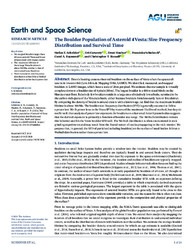The Boulder Population of Asteroid 4 Vesta: Size‐Frequency Distribution and Survival Time
Schulzeck, Franziska
Schröder, Stefan E.; Carsenty, Uri; Hauber, Ernst; Schulzeck, Franziska; Raymond, Carol A.; Russell, Christopher T., 2021: The Boulder Population of Asteroid 4 Vesta: Size‐Frequency Distribution and Survival Time. In: Earth and Space Science, Band 8, 2, DOI: 10.23689/fidgeo-4037.
 |
View/
|
Dawn's framing camera observed boulders on the surface of Vesta when the spacecraftwas in its lowest orbit (Low Altitude Mapping Orbit, LAMO). We identified, measured, and mapped boulders in LAMO images, which have a scale of 20 m per pixel. We estimate that our sample is virtually complete down to a boulder size of 4 pixels (80 m). The largest boulder is a 400 m‐sized block on the Marcia crater floor. Relatively few boulders reside in a large area of relatively low albedo, surmised to be the carbon‐rich ejecta of the Veneneia basin, either because boulders form less easily here or live shorter. By comparing the density of boulders around craters with a known age, we find that the maximum boulder lifetime is about 300 Ma. The boulder size‐frequency distribution (SFD) is generally assumed to follow a power law. We fit power laws to the Vesta SFD by means of the maximum likelihood method, but they do not fit well. Our analysis of power law exponents for boulders on other small Solar System bodies suggests that the derived exponent is primarily a function of boulder size range. The Weibull distribution mimics this behavior and fits the Vesta boulder SFD well. The Weibull distribution is often encountered in rock grinding experiments and may result from the fractal nature of cracks propagating in the rock interior. We propose that, in general, the SFD of particles (including boulders) on the surface of small bodies follows a Weibull distribution rather than a power law. Key Points:
We mapped boulders larger than 60 m on asteroid Vesta and found all associated with impact craters.
The maximum lifetime of these large Vesta boulders is about 300 Ma, similar to that of meter‐sized lunar boulders.
Their cumulative size‐frequency distribution is best fit by a Weibull distribution rather than a power law.
Statistik:
View StatisticsCollection
This is an open access article under the terms of the Creative Commons Attribution License, which permits use, distribution and reproduction in any medium, provided the original work is properly cited.

